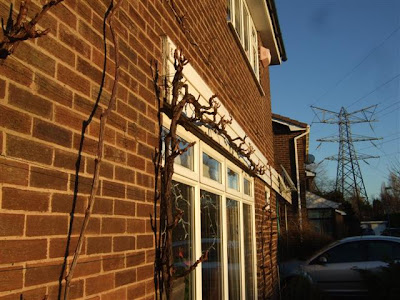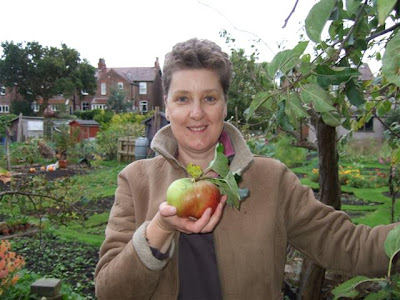Sunday 21st December - the shortest day ...
at last. I can't be doing with all this doom and gloom (and not just the economic/financial variety either!)
Anyway, it's been some time since I posted anything on my blog so I thought I'd do a bit of an update on the state of the vines. December is the ideal time for pruning them (in the Northern Hemisphere, that is!) and that's what I started doing this morning.
These shots should give an idea of what the vines look like before pruning. Note that vines are deciduous, and all the leaves have fallen by now:






In the case of the vines in the open ground (as opposed to against the wall) I've adopted the
Guyot system. The idea is to remove all but two or three good strong shoots of the previous season's growth. One (for
Single Guyot) or two (for
Double Guyot) of these shoots - technically known as "rods" - are tied to the bottom wire. If two rods are used, then one will be taken to the right of the main stem, the other to the left. The pic below shows a plant that has been partially pruned, with only one rod tied in:

I'm afraid at this time of year everything tends to be the same colour, so the contrast wasn't too good. However, I had a brain-wave: why not put a white sheet behind the subject? That certainly helped:



The next stage was to tie a rod to the other side of the stem, and completely remove the surplus one (as it is not needed).
Here's the finished job:

Once growth starts again in spring, the rods that have been tied into the bottom wire will produce "laterals" (
rather a daft name in this instance because they will actually be growing more-or-less vertically upwards!). The laterals will - hopefully - bear fruit.
You maybe noticed there's another rod, much shorter than the others, sticking up at the rear of the main stem. It is important to keep one rod pruned in this way, so as to leave at least three good buds ("eyes"). These should develop into three new rods which will form the basis of the following season's crop - and they will be treated in the same way at the end of
next growing season. (During the coming season these rods will not be allowed to bear fruit, but will simply be tied into the vertical cane).
I reckon it's also a good idea to think about extending your stock of plants at this time, and the prunings make ideal cuttings. I just bundle them up with a label (VERY IMPORTANT if you grow more than one grape variety) and "heel" them into the boarder in the greenhouse like this:


Then, around February they can be prepared as for any other type of hardwood cutting, and simply pushed into a convenient bit of spare ground. The base of each cutting should preferably be in a sandy or gritty medium, but in my experience it's almost impossible to prevent them from rooting, no matter what kind of soil they're in, provided it doesn't get water-logged.
A couple of years ago I did just that with some Madeleine Angevine prunings, and today I dug them up:

As you can see, they're all nicely rooted. Again, I heeled them into the greenhouse boarder, and when I get a spare hour or two I'll pot them up into something like John Innes No.2. From then on they can be potted on progressively, until big enough to plant out in a "vineyard". Of course I don't actually possess such a thing, but I do have my name down for an allotment!
I realise I haven't mentioned how the wall-vines are pruned. If anything they are even easier to deal with, but as I ran out of time they will have to wait for another day. I'll post some more information then.
Meanwhile, Happy Solstice. Oh yes, and
Merry Christmas!Mike


















































